Menus
- Ready-to-use work of art
- Triumph Trident T160 sparkles with chrome
- "Three cylinders are the absolute maximum “
- One triple, two ways
- An engine like velvet and silk
- Simple and yet eventful
- Expert advice
- In detail: Triumph Trident T150V / T160
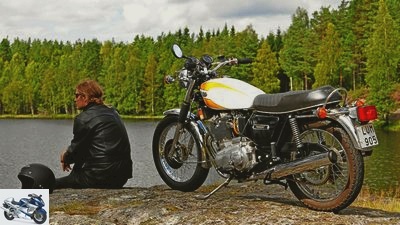
Blacksmith
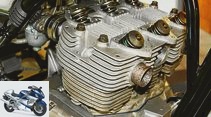
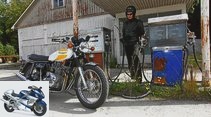
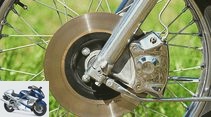

16 photos
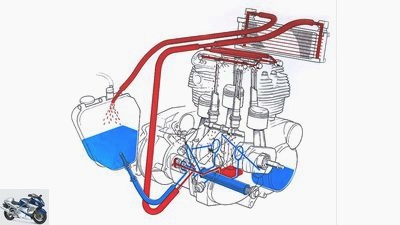
Blacksmith
1/16
The three-cylinder requires sensitivity, you have to put yourself in it.
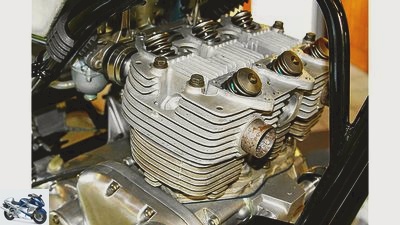
Blacksmith
2/16
The oil channel of the left crank pin often clogs, which is a serious consequence.
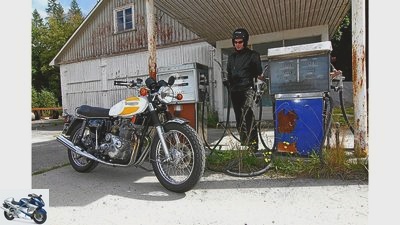
Blacksmith
3/16
Not just when stopping to refuel…
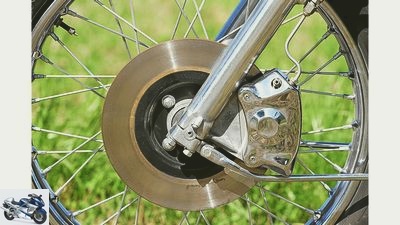
Blacksmith
4/16
…the single disc at the front only brakes moderately.
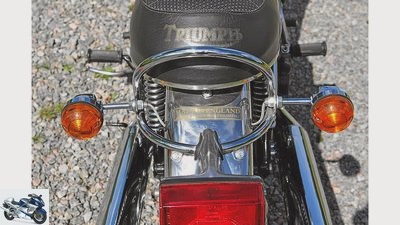
Blacksmith
5/16
Made in England: The Trident comes from the "Norton Villiers triumph"-era.
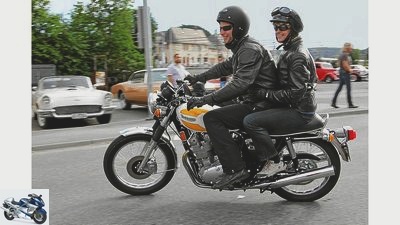
Blacksmith
6/16
Mike and Katharina have a lot of fun (and space) on the Trident not only with their close neighbors in Norway.
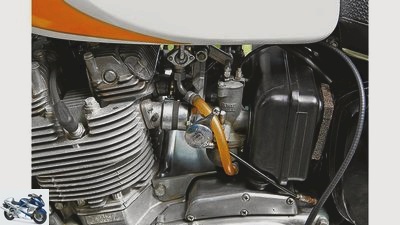
Blacksmith
7/16
Only real with swabs: three 27 mm Amal round slide carburetors.
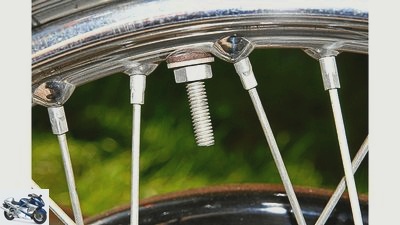
Blacksmith
8/16
Clever: On the rear wheel, like in enduro sports, two inner tire clamps hold the tire in the targeted position.
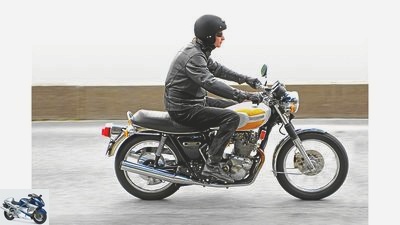
Blacksmith
9/16
When Mike sits on the Trident, he only beams: “This is where I belong!”
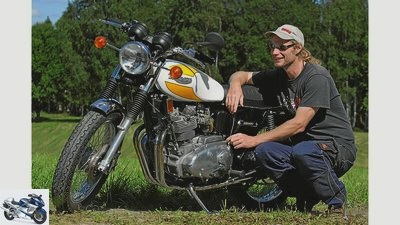
Blacksmith
10/16
Proud of ownership: Mike Doubrawsky is very happy about his sweetheart.
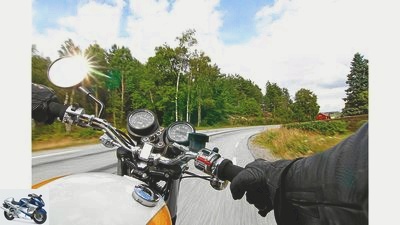
Blacksmith
11/16
The experience value is enormous. Even those who despise four-cylinder will love the triple.
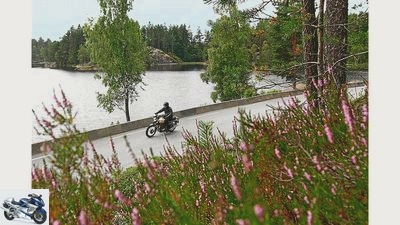
Blacksmith
12/16
The Trident is also good for touring.
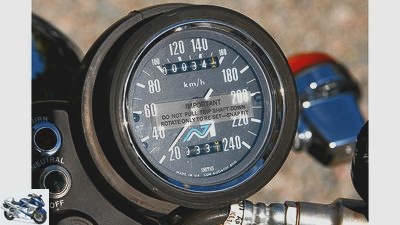
Blacksmith
13/16
Your mileage after a long time in a museum? 34 only!
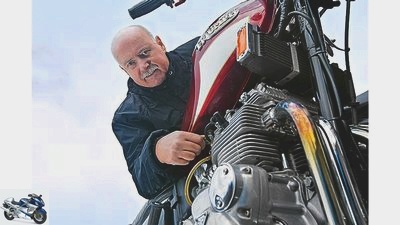
Blacksmith
14/16
Bernd Neitzert (63) from Mendig has five Tridents, drives VFV races with them and gives technical seminars for triple drivers.
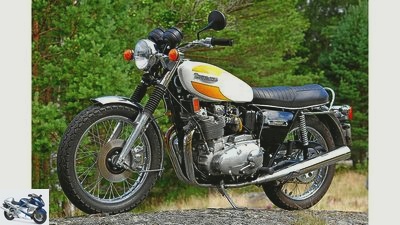
Blacksmith
15/16
A beautiful sight: the Triumph Trident T160.
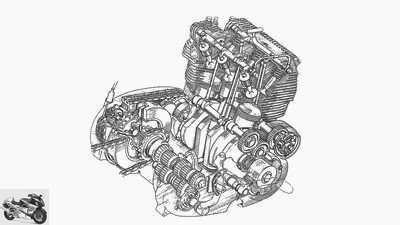
Blacksmith
16/16
The slightly long-stroke bumper motor with gray cast iron cylinder liners is quite complicated and not very easy to maintain. For connoisseurs …
On the move with the Triumph Trident T150V / T160
Ready-to-use work of art
Content of
Fairytale-like, but true: a 35-year-old Triumph Trident T160 has awakened from its slumber in the middle of the land of moose, forests and trolls. With 34 kilometers on the clock!
It all started in autumn 2011 with a short, terse email to the MOTORRAD editorial team, who were looking for an owner of a Triumph Trident: “Hey, I’ve got one Trident T160 Bj. 76. New condition! Mileage: 15 km (real), picture attached. “That’s it. And in the photo this Triumph already shone in fantastic condition. Wait a minute, a 35 year old triple like fresh out of the factory? How can that be? Telephone calls to Mike Doubrawsky, the owner, followed. Now MOTORRAD Classic’s interest was aroused. Mike is Thuringian, but lives mainly in Sweden, in the Dalsland province, 200 kilometers north of Gothenburg.
Triumph Trident T160 sparkles with chrome
In the summer of 2012, the author was finally able to saddle up a motorcycle that covered around 1500 kilometers from Stuttgart to Nossemark. Full of anticipation and impatience. The Trident T160 looks even better live. Shines seductively with white and yellow paint under the wide, bright blue Swedish sky, sparkles with its chrome, in which the green of the dense forests is reflected. And Mike, 1.93 meters tall and slim, welcomes you warmly, just like his wife Katharina. Both were born in 1966 and have built a new life here. They offer rooms in a picture-perfect farmhouse that they have renovated themselves, rent canoes, bicycles and motorbikes, raise sheep and have an apple plantation.
Blacksmith
Mike and Katharina have a lot of fun (and space) on the Trident not only with their close neighbors in Norway.
At home in Thuringia there are plenty of other motorcycles, a Norton ES 2 and a Gilett Herstal 250, for example, plus a 175cc Motoconfort and a Horex Regina. But here, just before the Norwegian border, the Triumph Trident T160 is the undisputed star. One day it was on the website of the Swedish motorcycle dealer Oves Motor in Olofstrom. In addition to current machines, he always has interesting historical motorcycles on offer (www.ovesmotor.se/klassik, phone 00 46 / (0) 4 54/30 90 90). And exactly on this website one evening this very special, as good as new Trident was advertised.
"Three cylinders are the absolute maximum “
For the self-confessed V2 fan Mike “three cylinders are the absolute maximum”. But a triple in this condition, the master coachbuilder and two-wheel mechanic was electrified, immediately wrote an email and confirmed his specific purchase intent by phone the next morning. With success. A deal was reached during the tour. There was only one tiny catch – that low mileage. It was no accident. The trident has been sleeping for several decades – as an exhibit in a Swedish motorcycle museum.
And Mike wanted to buy a vehicle, not an ornament. So renegotiate with Oves Motor – the triplet must be freed from damage to the stand and made ready to drive again. This entailed an extensive engine overhaul and delayed delivery by months. The wait was worth it! Because now there is a mechanical sculpture, a work of art ready for use. A motorcycle made from one piece. One to admire and touch. To be taken quite literally for the wonderful start-up procedure: open both petrol taps. The two outer, 27 millimeter large Amal round slide carburetors also supply the float chamber of the middle one. So before the cold start, dab until it overflows – and go!
The three-cylinder comes on first step. Despite or because of the low mileage, blue oil clouds accompany his awakening. Kick or press a button – the Trident T160 from 1975 gives you the freedom to choose. The previous model T150, released in 1968, had to do without an electric starter. Likewise on disc brakes and a fifth gear. So late, it wasn’t until the middle of the 1970s that Triumph had arrived halfway in the modern motorcycle era.
Flashback: Named after the trident of the sea gods Poseidon (Greek) and Neptune (Roman), the 750 three-cylinder was supposed to save what could still be saved. The omnipresent desire for more power spurred the development of large-displacement multi-cylinder engines in the 1960s. Triumph could no longer resist this trend. However, in order to avoid the costs of a completely new development, the three-cylinder was structurally based on the 500 twin engine, and the British basically simply docked on another cylinder. Accordingly, bumpers with rocker arm shafts took over the valve control of the ohv engine with two lower camshafts in front of and behind the cylinders.
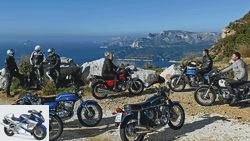
classic
On the move: Benelli 750 Sei, BMW R 90 S, Honda CB 750 Four, Kawasaki 750 H2, Norton Commando 750 Roadster, Suzuki GT 750
Out and about with the motorcycle icons of the 70s
read more
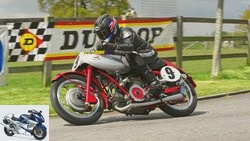
classic
Moto Guzzi 500 Bicilindrica
Racing history with 120-degree V2
read more
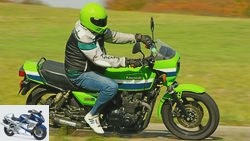
classic
On the move with the Kawasaki Z 1000 R.
Serial offshoot of the US Superbike championship motorcycle
read more
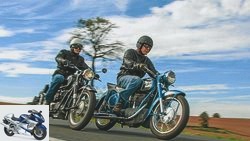
classic
In comparison: BMW R 26 and Simson AWO 425 S.
Same parts – BMW R 26 and Simson AWO 425 S.
read more
One triple, two ways
Technically a solution on the level of the early, not the late 1960s. The drive unit, which was developed in cooperation with BSA and built there, drew a nominal 58 hp at 7250 rpm from 740 cubic centimeters. With a 67 millimeter bore and a 70 millimeter stroke, the British triple was still a moderate long-stroke. The almost identical BSA Rocket 3 also powered this triple. On the Triumph, the cylinders with the cast iron bushings were vertical, on the BSA they were inclined a little forward. As later, from 1975, also with the Triumph Trident T160. While BSA preferred a double loop, Triumph stuck to the tried and tested monotube frame. So the frame sternum got in the way of the middle bend.
The bend of the middle cylinder therefore forks around the beam of the single-loop frame. All elbows lead into a collector below the gearbox. From there it goes into two slim, elongated, chrome-plated and quite unadorned silencers on the left and right. Inimitable: the three-cylinder sound. The Trident sounds dignified, hoarse and yet unobtrusive. A tube that goes under the skin. It is vaguely reminiscent of an air-cooled Porsche 911, just half a six-cylinder. Just great. You almost forget that the three-cylinder Triumph was the last rearing up.
An engine like velvet and silk
Even in the lowest speed range, the triplet runs nice and smooth. Good torque is available from 3000 tours, noticeable extra thrust from 4000 rpm. According to Trident expert Bernd Neitzert (top right), a well-adjusted engine can handle even high continuous speeds. MOTORRAD also experienced this in the 12/1969 issue with the four-speed T150 in a motorway test. But here in the Swedish pampas, motorways are as far removed as China is from democracy. And besides, this Trident is still in the “recovery phase” after the long museum period, Mike has not asked for more than 5000 tours so far. That is enough to lively surf the surprisingly winding country lanes in Elk Land. The translation of the speedometer drive did not fit. Because of this, he displayed the pace incorrectly. In order not to be confused, Mike unceremoniously disconnected it at 34 km. And such a unique sight on the stylish Smiths watch is preserved for the time being. In general, the triple doesn’t get very good air. The intake snorkel is inconvenient and leads down to the right behind the cylinders. The two-plus-one twin thus draws in air that has already been heated. That is not performance-enhancing. Well, actually the entire basic construction was no longer completely up to date when it appeared in 1968.
Simple and yet eventful
Excellent, easy handling characterizes the driving behavior of the machine, which weighs 230 kilograms. It drives as good as it looks! The chassis looks better than that of many Japanese people in the early 80s. Not underdamped, even surprisingly tight, fork and girling struts respond well to bad bumps and lots of stones. After all, the first one or two kilometers from Mike’s house is an unpaved dirt road. “The English lady has to be able to do that.” This chassis is a good compromise between easy-to-swallow-comfortable and trust-inspiring stable. The fork tubes are hidden under both classically beautiful and practical bellows.
35 years old and only 34 km on the clock – a real rarity.
The Triumph chassis was structurally a reinforced 650 parallel twin frame. The fork, which was also borrowed from the two-cylinder engines, was given stronger springs to cope with the additional weight of the third cylinder. The 18-year-old Dunlop Roadmaster tires with their thick tread blocks offer good self-damping. But also liability? Well, take it easy. Especially since their edge suddenly comes at some point. Fortunately, narrow as they are, they only need a slight lean angle for decent cornering speed. A 19-inch model rotates at the front and an 18-inch wire-spoke wheel at the rear.
With 58 hp, it was supposed to hold its own against Honda’s centenary motorcycle, the CB 750 Four, and later against Kawasak’s powerful Z1 and BMW’s sporty R 90 S. A hopeless fight. But today the mildness of old age is over it. Take a seat, please. The rounded, elegant tank, much nicer than the angular fuel canister of the T150, offers drivers of all ages great knee protection. The rather flat, neither too narrow nor too wide handlebar is no longer original, originally it was a much higher mini deer antler. He is ideally cranked for this and comes towards the driver as politely and courteously as an English butler.
Okay, the foam rubber handles are a clear break in style. But comfortable. Just like the male rider seating position. The long, straight bench is thickly padded without being too soft. It offers enough space for the grown-up owner couple. Katharina, 1.74 meters tall, feels really comfortable on the back, likes to go with you. You sit better than on a current Triumph Bonneville. Higher, with more distance to the solid rubber footrests.
The single-disc dry clutch works quite inconspicuously, the first gear engages gently (shifted to the left on the T160!). The trident sets itself in motion with a high level of experience from the first meter. With great smoothness: you can feel that the engine is running without ever suffering from vibrations. The 120-degree crankshaft has four bearings: two plain bearings in the middle, one ball bearing on the left and one roller bearing on the right stump.
Blacksmith
The experience value is enormous. Even those who despise four-cylinder will love the triple.
The front single disc combines little manual force with the same braking effect – using the rather powerful rear stopper is urgently recommended. But precisely such quirks contribute to the intense driving experience. You can feel this motorcycle with every fiber of your body. Certainly it wasn’t the best motorcycle of its time. But today, especially in this pristine condition, it is one of the most fascinating. When Mike sits on the Trident, he only shines: “This is where I belong!” He happily uses it for enjoyable rides, although he also has other motorcycles in Sweden.
When looking for the few missing parts, such as original repair instructions, the English specialist Herbert Gubba recommended a good address (www.glm-british-motorcycles.de, phone 0 51 82/5 18 31). Mike put ignition cables and wire spokes from him on the shelf. If you want to get a picture of this Hammer-Trident for yourself (it will always keep its first Swedish license plate LUM 905), or even combine it with a vacation between lakes and forests – the possibilities in the far north are many: Mike can be reached at www.villa-smile.com and phone 0157/77 81 33 77. It’s worth it
Expert advice
Big problem with the crankshaft: unequal pressure conditions and flow.
The triple expert advises:
If the three-cylinder has been carefully assembled, it is reliable and resilient, according to Bernd Neitzert. And tight too. There is a big problem with the crankshaft: the right main bearing supplies the right and middle crankpins with fresh oil, the left main bearing only the left crankpin. Uneven pressure conditions and flow are the result, and the canal on the left is often clogged with oil sludge. Often caused by poor oil quality, oil change intervals that are too long, or both. To counter this, Bernd Neitzert drills a connecting hole from the center crank pin to the left main bearing. Danger recognized, danger averted.
The original valve guides are usually worn out after 10,000 to 20,000 kilometers. The oil supply of the dry sump lubrication is sensitive: the oil channel of the left crank pin often clogs, a “seizure” is the serious consequence.
In detail: Triumph Trident T150V / T160
Blacksmith
Price of the Trident T160 in 1975: 6310 marks.
technology
The three-cylinder construction is based in principle on Triumph’s time-honored Twins. In order to be able to continue using tried and tested components, the housing was complex, with many covers, sealing surfaces, threaded rods and locating pins. For the valve train, gears on the right drive the intake camshaft behind and the exhaust camshaft in front of the cylinder base. From there, short rockers and bumpers lead to the upper floor. Here, a rocker arm shaft rotates on the inlet and outlet side in order to control two valves per cylinder using a rocker arm. A triplex chain takes over the primary drive, on the T160 from 1975 a duplex chain. A five-speed gearbox was already available from 1972. Screwing the triple is something for experts: In order to get to the crankshaft, the engine, including the gearbox, has to be dismantled into all its individual parts. To remove the drive pinion, the primary drive and dry clutch must first be dismantled. There is no longer any replacement for worn duplex chains. Tip: Convert to a toothed belt, which requires a different clutch release bearing!
Checkpoints
It is not uncommon for the engine to leak from housing seals and tappet tubes. Because the rocker arms exert pressure on one side of the valve stems, their guides quickly deflect. Increased oil consumption (blue clouds when taking off the gas!) Are the result. This is remedied by valve guides made of modern, harder material and a valve stem seal on the inlet side. Very important: The Triple regularly requires fresh lubricant so that no oil deposits can form. It is highly recommended to replace the vulnerable original ignition system with breaker contacts from Lucas with an electronic ignition from Tri-Spark (www.trispark.com.au). Furthermore, the outdated electronics for the rectifier and charge control of the battery should be replaced with more modern charge regulators. Then the ignition and electrical systems are absolutely modern.
market
Taken together, only 27,500 BSA Rocket 3 and Triumph Trident were made. And around three quarters of them went to the USA. That makes the range of British tridents in Europe and Germany very manageable. In view of the rather complex technology, however, the demand was also kept within narrow limits. This seems to be changing now: Apparently more enthusiasts are approaching the unusual model, whose engine concept carries the success of the re-established Triumph brand within itself. Anyone who gets in now can buy a fine motorcycle for moderate money. Even top copies cost less than 10,000 euros; The rarer BSA Rocket 3 are slightly more expensive.
Data (Trident T160)
Engine: Air-cooled three-cylinder four-stroke in-line engine, two underlying camshafts (ohv), two valves per cylinder, operated via bumpers and rocker arms, displacement 740 cm³, bore x stroke 67 x 70 mm, compression 9.5: 1, power 43 kW ( 58 hp) at 7250 rpm
Power transmission: single-disc dry clutch, duplex primary chain, five-speed gearbox, secondary roller chain
Chassis: single-loop frame made of tubular steel, telescopic fork at the front, tubular steel stereo swing arm with Girling suspension struts, three-way adjustable in the spring base, wire-spoke wheels with steel rims, tires 4.10 H 19 at the front, 4.10 H 18 at the rear, disc brake front / rear, Ø 254 mm
Dimensions and weights: tank capacity 21.8 liters, weight with a full tank 230 kg
Vmax: 193 km / h
Specialists
Bernd Neitzert
Telephone 01 60/96 62 99 80
Martin Ehrkamp company
Telephone 0 21 29/34 49 75
Clubs and forums
Triumph Motorcycle Owners Club e. V., TMOC
Telephone 06322/958688
http://www.tmoc.de
Classic British Bike Club e.V.
http://www.cbbc.de
Related articles
-
On the road with the BMW K 75, Triumph Trident T150 and Yamaha XS 750
fact 34 photos www.factstudio.de 1/34 Picture gallery, On the move: BMW K 75, Triumph Trident T150, Yamaha XS 750. www.factstudio.de 2/34 If you are into…
-
Cult bike: Triumph Trident 900
Schwab 16 pictures Schmieder 1/16 The three-cylinder requires sensitivity, you have to put yourself in it. Schmieder 2/16 The oil channel of the left …
-
Triumph T160 V-Speed Triple – Brands, Myths and Engines
Comparison test: Triumph T160 V / Speed Triple Brands, Myths and Engines In 2012, Triumph looks back on 110 years of motorcycle history….
-
24 photos triumph 1/24 Triumph Tiger 800: The three-cylinder engine generates 95 hp at 9300 rpm from 799 cubic meters. triumph 2/24 Triumph…
-
Triumph Trident Cafe Racer reader conversion
Thomas Grad 10 pictures Thomas Grad 1/10 Triumph Trident Cafe Racer Thomas Grad 2/10 The handlebar fittings milled from aluminum by Motogadget look great …
-
MV Agusta Brutale 800 versus Triumph Street Triple R
Jahn 15 pictures Jahn 1/15 The hot naked bikes: MV Agusta Brutale 800 and Triumph Street Triple R in a comparison test. Jahn 2/15 The …
-
Triumph Street Triple series test
Rossen Gargolov 32 photos r-photography.info 1/32 Triumph Street Triple RS: power 123 hp, weight 190 kg, price 11600 euros Triumph Street Triple S: power…
-
Triumph Speed Triple and KTM Super Duke in comparison
fact 17th photos fact 1/17 Both bikes are full of power and emotions and can really sweep the rider away, but which one can impress more, the KMT 990…
-
Triumph Daytona T595 test Almost lady The UK motorcycle industry has its own representative: the Triumph Daytona T595. She represents the super sports…
-
Triumph Trident 660: New three-cylinder roadster
New Items 2021 Motorcycle New Items 2021 Triumph 45 Pictures Triumph 1/45 Triumph wants to stir up the segment of mid-range roadsters. Triumph 2/45 …